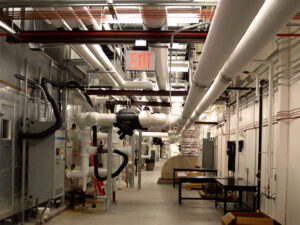Monitoring based commissioning (MBCx) is a data-driven, performance-focused approach to building optimization that continuously evaluates building systems using real-time data. Unlike traditional commissioning, which typically concludes after a building is occupied, MBCx extends into the operational phase of a facility’s lifecycle. It combines the initial commissioning process with ongoing diagnostics to ensure systems perform optimally over time.
At its core, monitoring based commissioning leverages real-time monitoring tools and advanced analytics to assess building performance metrics, detect inefficiencies, and enable proactive maintenance. This continuous approach is critical for maximizing energy efficiency, reducing operational costs, and promoting long-term sustainability in construction and facility management.
While traditional commissioning validates performance at turnover, monitoring based commissioning provides ongoing oversight. It enables facilities to adapt to changing usage patterns, respond quickly to system faults, and uncover optimization opportunities that would otherwise go unnoticed. For building owners and operators, MBCx offers a powerful tool for aligning performance with long-term operational goals.
Related to concepts like continuous commissioning and sustainability in construction, monitoring based commissioning supports measurable improvements in building efficiency and occupant comfort. It is especially impactful in existing building commissioning projects, where it ensures older systems meet today’s performance standards without major infrastructure overhauls.

Key Components of the Monitoring Based Commissioning Process
One of the defining advantages of monitoring based commissioning is its ability to shift operations from reactive responses to proactive performance management. By continuously observing system data, facility teams gain the insights needed to address inefficiencies, fine-tune performance, and prevent problems before they escalate. This kind of real-time responsiveness is not only essential for achieving operational goals, but it also enhances occupant comfort, ensures compliance, and supports sustainability objectives.
The monitoring based commissioning process involves several key elements that enable consistent building performance evaluation and adjustment. These components work together to ensure that building systems operate efficiently and are responsive to real-time conditions.
- Building Automation Systems (BAS): BAS platforms serve as the backbone of MBCx systems by collecting and organizing real-time operational data from HVAC, lighting, energy, and safety systems. Integration with BAS allows for seamless data extraction, centralized control, and timely diagnostics.
- Data Analytics: Collected data is analyzed using specialized commissioning software tools to identify performance trends, inefficiencies, and anomalies. Through data visualization dashboards, facility managers can interpret building behavior and make informed decisions.
- Commissioning Software Tools: Tools such as energy dashboards, analytics platforms, and fault detection software automate many MBCx tasks. They streamline reporting, generate actionable insights, and facilitate collaboration among stakeholders.
- IoT Integration: Internet of Things (IoT) sensors enhance monitoring by enabling granular data collection on temperature, humidity, occupancy, and equipment performance. When combined with advanced analytics, this data provides a detailed view of system interactions and energy consumption patterns.
- System Calibration and Optimization: Fine-tuning equipment settings and control sequences ensures peak efficiency. Regular adjustments help align system outputs with actual building usage, which is often more dynamic than anticipated during design.
These components, supported by robust project management and stakeholder engagement, form the foundation for effective monitoring based commissioning implementation. They allow teams to identify root causes of performance issues, validate fixes, and continuously improve building operations. A thoughtful commissioning process is essential in both retrofit and new construction commissioning projects to ensure smooth system transitions.
Benefits of Real-Time Monitoring in Building Performance
One of the defining advantages of monitoring based commissioning is its ability to shift operations from reactive responses to proactive performance management. By continuously observing system data, facility teams gain the insights needed to address inefficiencies, fine-tune performance, and prevent problems before they escalate. This kind of real-time responsiveness is not only essential for achieving operational goals, but it also enhances occupant comfort, ensures compliance, and supports sustainability objectives.
Real-time monitoring transforms building operations by enabling a proactive, rather than reactive, approach to maintenance and performance optimization. Some of the key benefits include:
- Energy Efficiency: Monitoring based commissioning enables fine-tuning of systems based on real-time conditions, leading to measurable energy savings. For example, detecting an overactive air handling unit or an improperly calibrated thermostat can significantly reduce energy waste.
- Operational Cost Reduction: Early identification of equipment faults or performance degradation helps avoid costly repairs and unplanned downtime. Automated fault detection and diagnostics streamline maintenance planning.
- Improved Comfort and IAQ: Continuous data tracking allows for better control of indoor air quality and thermal comfort. Adjustments can be made to meet occupant needs while maintaining energy goals.
- Regulatory Compliance: Monitoring based commissioning helps facilities meet energy codes and sustainability standards by maintaining consistent performance metrics and documentation.
- Predictive Maintenance: By analyzing system performance trends over time, MBCx supports predictive maintenance strategies. This enables facility teams to replace or service components before failure occurs, reducing downtime and improving service continuity.
- System Longevity: Systems that operate efficiently experience less wear and tear. As a result, buildings implementing MBCx strategies tend to enjoy longer equipment life cycles, providing additional cost savings.
Case studies of commercial and institutional buildings implementing MBCx systems have demonstrated 10-15% reductions in energy consumption and significant improvements in occupant satisfaction. In commercial building commissioning applications, these improvements support not only sustainability targets but also operational reliability across a wide portfolio of facilities.
Tools and Technologies Used in Monitoring Based Commissioning
The effectiveness of monitoring based commissioning hinges on the integration of smart technologies that can support dynamic building environments. As buildings evolve and become more complex, tools that enable real-time insights and scalable performance tracking are essential. These technologies empower facility managers, engineers, and operations teams to proactively manage systems, address inefficiencies, and adapt to changes without compromising comfort or compliance.
Monitoring based commissioning relies on an evolving set of technologies that enable comprehensive and scalable performance tracking. These include:
- Smart Building Technology: Integrated systems that link HVAC, lighting, and energy management platforms for centralized, automated control.
- Smart HVAC Systems: Advanced HVAC equipment equipped with embedded sensors and diagnostics for real-time performance monitoring.
- Commissioning Software Tools: Platforms such as Clockworks, SkySpark, CopperTree, and Fault Detection and Diagnostics (FDD) software that analyze and visualize building performance.
- IoT in Building Management: A network of wireless, low-power sensors deployed throughout the building to collect real-time environmental and equipment data.
- Energy Management Software: Solutions that track energy consumption, benchmark usage, and support sustainability initiatives across portfolios.
- Cloud-Based Data Platforms: These allow teams to access building performance dashboards remotely, collaborate across locations, and maintain centralized data repositories. As buildings adopt more cloud infrastructure, this approach becomes even more scalable and secure.
- Mobile Tools for Field Teams: Mobile-friendly commissioning tools and apps enable technicians to receive alerts, review trends, and document system adjustments in real time, streamlining workflows and reducing response times.
These tools not only enable data-driven commissioning but also position building owners for future integration of artificial intelligence (AI) and machine learning for even greater insight and automation.

Challenges and Solutions in Implementing Monitoring Based Commissioning
While monitoring based commissioning delivers measurable improvements in energy performance and operational reliability, implementing it successfully requires navigating several real-world challenges. Understanding these hurdles is essential for setting realistic expectations, building stakeholder support, and deploying the right tools and strategies from the outset. From technical integration to staffing limitations, organizations must plan proactively to get the full value from their MBCx investment. Below are key challenges and practical solutions that help ensure long-term success.
Despite its benefits, monitoring based commissioning presents several challenges that must be addressed for successful implementation:
- Data Overload: The vast amount of data generated can be overwhelming without the right tools and expertise. Solutions include using analytics platforms that prioritize actionable insights and filter noise.
- Integration Complexity: Integrating MBCx with existing BAS and legacy systems can be technically challenging. This requires selecting compatible technologies and involving integration specialists early in the process.
- Resource Constraints: Skilled personnel are required to interpret data and act on insights. Partnering with experienced commissioning providers like Cornerstone Commissioning can help fill this gap.
- Stakeholder Engagement: Sustained success depends on engagement across facilities, IT, and operations teams. Training and communication strategies are essential to maintain buy-in and consistent execution.
- Upfront Investment: Though MBCx reduces costs over time, the initial setup—including sensors, software licenses, and integration—can be a barrier. A phased implementation plan can help manage budgets while still achieving performance goals.
Best practices include starting with high-priority systems (e.g., HVAC), establishing clear performance goals, and scaling over time. Continuous commissioning and automated fault detection play important roles in maintaining system health and addressing issues before they escalate.
The Long-Term Value of Smarter Commissioning
Monitoring based commissioning redefines how buildings are optimized, shifting from static, one-time evaluations to a dynamic, continuous process rooted in data and technology. It enhances the traditional commissioning process by layering in real-time monitoring, predictive diagnostics, and performance analytics that ensure buildings operate as efficiently on day 1,000 as they did on day one.
As buildings become smarter and more connected, monitoring based commissioning will play a central role in energy efficiency, sustainability, and operational resilience. The ability to make informed, data-backed decisions about system performance not only improves building value—it elevates the occupant experience.
At Cornerstone Commissioning, we apply the same rigor and expertise to monitoring based commissioning that we bring to our traditional commissioning services. Whether you’re planning a retrofit or pursuing new construction commissioning, we help clients implement MBCx strategies that are thoughtful, scalable, and built for long-term success.
Contact our team today to learn how we can support your monitoring based commissioning goals.





